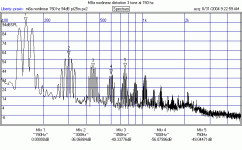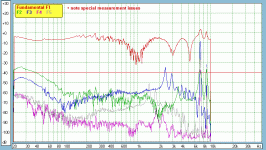Ok, that was good. That made me chuckle.
Too bad the sound of the moving motorcycle is going to be subject to the Doppler effect and so the tone will be changing, so (just for this example) if the timber of the front soundstage is exactly perfect it probably won't matter.
So then -
MOTORCYCLE - Motorcycle - motorcycle ?
Steve
But aren't you also apt to cross to the tweeter lower in a 2-way than a 3-way (say 2kHz instead of 3kHz)? So that band would definitely not timbre match. You could always just cross them all at the best point for the woofer in the 2-way, but that is not likely to be using mid or tweeter best in the 3-way.
Xo points should definitely be different but think of timber in terms of both frequency response (FR) and harmonic distortion.
The FR is the summed response of all drivers that are being used in the speaker. 3dB is considered the minimum change in SPL that the average person can perceive as louder/quieter (actually, this depends on the person and what frequency we’re talking about but that’s a whole other discussion). That means that 2 different FR’s that are within plus or minus 3dB of each other are likely to be perceived as about the same and that’s regardless of where the xo point is or if it's a 2-way or 3-way etc. That can be difficult to achieve but it’s not unreasonable for a good xo designer.
However, even if 2 different speakers have the exact same FR, they are still unlikely to sound exactly the same unless they use the exact same drivers and xo’s and that’s because different types of cone materials all have slightly different resonant/damping characteristics. Think of it this way. A guitar, violin or piano can all play the exact same note but each one will sound totally different because each one has a different harmonic profile or timber. Each instrument plays the fundamental note but also includes higher and lower octaves, 3rd's, 5th's and so forth. Same thing for drivers. Each one has its own sonic signature. Feed the driver a pure tone as the fundamental, and the driver will reproduce that as well as a handful of other tones as well. That’s harmonic distortion.
Another graph below. Instead of showing the distortion profile across the whole frequency spectrum, this one just shows what happens with a single frequency. If the driver could reproduce that tone perfectly, then you’d only see a single, narrow spike at the fundamental, 150Hz. Don’t ask me why, but when a signal is input into a driver, it also reproduces that tone by factors of 2, 3, 4, 5 and so on, usually with diminishing SPL. So as well as 150Hz (this is incorrect but let’s just call the note an E), you can see the 2nd spike at 300Hz (E again, an octave higher – so not unpleasant), the next one’s at 450Hz (somewhere around A sharp which is kind of dissonant), another at 600Hz (the next octave – so again benign) and the next at 750Hz (again A sharp – dissonant). (As an aside, if you want to know what that sounds like leave it to Rush to put E, A sharp and E together for an effective dissonant chord structure in this song at about 34 seconds in. Rush - Secret Touch (Restored Version) - Dynamic Range 11 - YouTube)
So in order, those are the 2nd, 3rd, 4th and 5th order harmonic distortion responses of that driver when trying to reproduce a pure 150Hz tone. The same thing occurs with every note right across the full frequency range but each with differing SPL levels which is what you see in the other distortion graphs we’ve been presenting. So, what’s going to be the threshold for a noticeable difference here? Again the same +/- 3dB for each type of distortion, but as I say, this is still not as important as matching the FR’s. Look at the SPL levels of the distortion responses – anywhere from 30 to 60 dB quieter than the fundamental.
There are actually a few more factors that shape the speaker’s timber but for our purposes I think I can stop there.
So, best case scenario for timber matching: 5 identical speakers.
Next best: 3-ways all the way around with the same drivers. CC gets the best room dispersion because of WT/MW configuration. FR and distortion shouldn’t be significantly different.
Third best: 2-way mains and 3-way CC with same type of drivers but in different sizes. FR may be within +/- 3dB and timber is going to be close because of the similar motors and cone materials but it’s still going to be a little different due to differences in harmonic distortion. Very noticeable? Not too likely.
But assuming xo and timbre matching is fine, would a Revelator W18 be better at 80 - 2.5kHz (or whatever xo point is) than a Seas L18 at 80-500/600 and the Audax covering higher? Won't the 1kHz - 2.5kHz signals be cleaner when the driver isn't also responsible for the higher power 80 - 500Hz range?
That’s the question isn’t it? If you use a higher quality driver as a mid/woofer or use 2 lesser quality drivers for the same range, which is better. Yes, there’ll probably be less intermodulaton distortion in the mid when used in a 3-way but does that mean the 3-way will be better? Depends of course on the drivers. And on how loud you want to play them. And others would say that you’re better off without the extra xo in there. For the money you’re spending and the SQ you are interested in, my thinking is that you should try to stay in the upper echelon of drivers. If the difference in SQ is high enough, the 2-way is probably going to trump the 3-way but if SPL is a top priority then the 3-way probably is the way to go. It would be great if someone who’s heard them could compare the Audax with other drivers like perhaps the Scan Discovery 10F which is also a great little driver. Or lower your box size priority a little and go with this planar driver, the B&G Neo8S, outstandingly clean planar driver DIY Speaker Components | Replacement Speakers | and Speaker kits from Meniscus Audio Group.
Actually the Q100 is the 5 1/4 UniQ, similar to my iQ1 rears. The Q300 is the 6 1/2 like the iQ3.
Darn.
I still think those 4 targets I set are a pretty good benchmark of comparison for you. 2nd graph below is for the L18 and hopefully you can see that it falls short.
Attachments
- Status
- This old topic is closed. If you want to reopen this topic, contact a moderator using the "Report Post" button.

